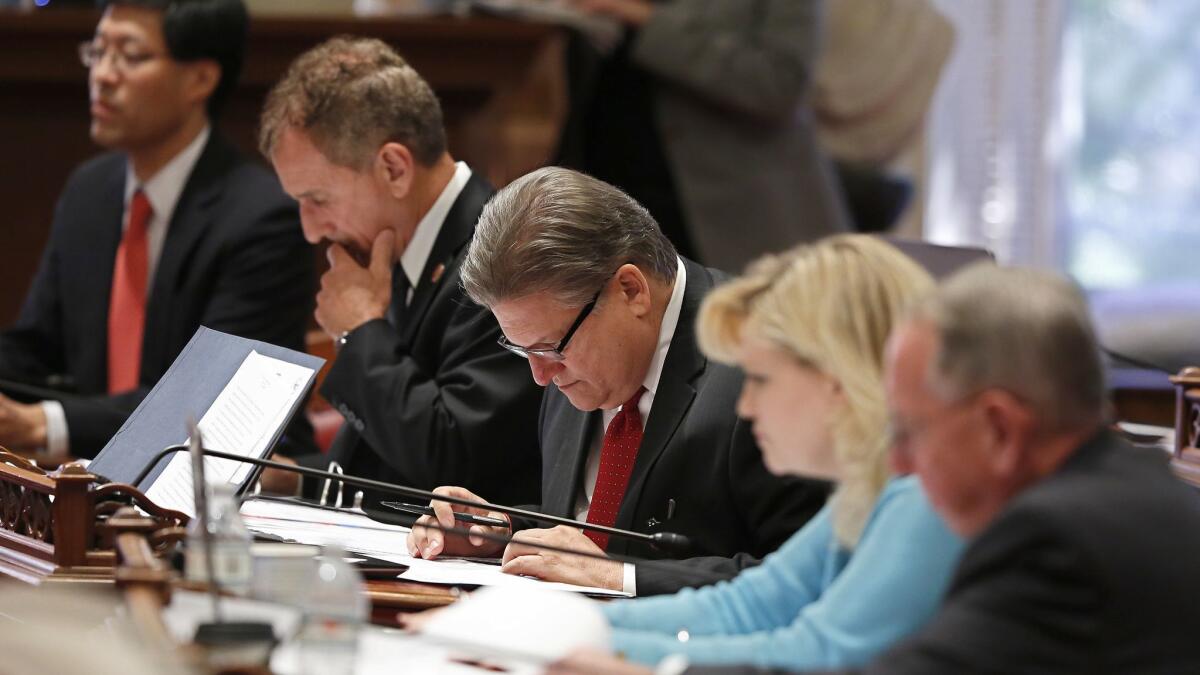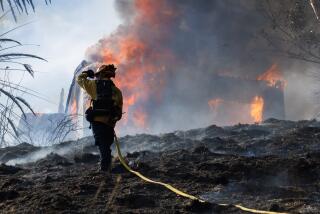California lawmakers ratify new efforts at wildfire prevention and assessing who’s responsible

Reporting from Sacramento — With an urgency sparked by two consecutive years of deadly fires, California lawmakers have sent to Gov. Jerry Brown a collection of proposed laws to bolster prevention efforts and the readiness of residents, along with a controversial plan in which utility companies could pass some wildfire-related costs onto customers.
The breadth of the public policy proposals that won final approval late Friday — including efforts to increase defensible space around homes and buildings, and a mandate for backup batteries in garage door openers that hinder a fast getaway when the power is knocked out — offers a reflection of how deeply the devastation has been felt by Californians and their elected representatives in Sacramento.
“We’re angry and we have every right to be angry,” Sen. Hannah-Beth Jackson (D-Santa Barbara) said on Friday night during the legislative debate. “The question is, what do we do about that?”
No proposal was more far-reaching or contentious than Senate Bill 901, the summer’s marquee wildfire measure and one of the last to be approved on Friday night before the Legislature adjourned for the year. The bill authorizes a five-year, $1-billion effort to reduce fire threats through tree and brush thinning programs that would include year-round prescribed fire. It would also streamline regulatory approval of fire reducing programs, and loosens some of the existing rules that govern the size of trees that can be removed.
Assembly GOP Leader Brian Dahle (R-Bieber), whose district felt the full brunt of the deadly Carr blaze that swept into Redding, held up a large map during debate on Friday that showed the fire danger across California.
“You’re going to burn if we don’t do something fast,” Dahle said as he moved the map from side to side so lawmakers could get a better look. “We need to turn California from red back to gold.”
But consumer groups and large industrial stakeholders were enraged by provisions in SB 901 that will offer financial help to utility companies. Though the bill was scaled back from an earlier effort to rewrite a liability standard that applies to the companies when their equipment is involved in sparking a fire, it nonetheless offers new power to the California Public Utilities Commission to offer concessions when appropriate.
It was the kind of change that threatened to derail the work of the special legislative committee that crafted the main fire proposal. A handful of lawmakers rekindled that frustration and anger on Friday, particularly when it came to a discussion of how SB 901 could offer relief to Pacific Gas & Electric Co., the utility found responsible in some of the Northern California blazes in 2017.
“Why are we rushing to bail out PG&E with its history of cutting safety as a business decision?” Sen. Jerry Hill (D-San Mateo) said.
The bill allows the company to borrow money for its 2017 wildfire costs while using money collected from ratepayers to pay back the loan. PG&E lobbied lawmakers heavily for help, warning that Wall Street investors could downgrade the company’s credit rating without relief from the Legislature. That, supporters said, could mean the San Francisco-based company and other investor-owned utilities facing fire costs would have to scale back ambitious clean energy efforts that are being counted on to help support California’s climate change agenda.
“Every single one of us can find problems in this report,” said Assemblyman Chad Mayes (R-Yucca Valley), who served on the conference committee that crafted the plan. “It is not perfect, but it is good.”
A series of other bills that moved through the Legislature in its final days aims to improve California’s fire readiness in the coming years. A second proposal, Senate Bill 1260, would give permission for more planned “prescribed” burns with an effort to cooperate across lands owned by the federal and state government, along with private landowners.
Assembly Bill 2911, also approved Friday, gives electric utility workers new access to private land to trim trees and brush away from power lines, and boosts other efforts to create defensible space around structures. An additional bill could provide financial incentives for landowners to profit from wood products made with small trees removed to aid in fire prevention.
Other efforts approved by lawmakers sought to bolster fire safety and protection. Senate Bill 833 would improve emergency alert systems in communities across the state. Even the danger faced by a garage door that won’t go up when the power is out — trapping a homeowner’s car and preventing a quick escape — was considered by the Legislature; a bill sent to the governor’s desk would require those door openers to be sold with backup batteries in place.
But questions remain about whether the bills, if signed into law, will do enough to protect communities where more Californians live.
“There’s too much focus on the rural areas, in my view,” said Michael Wara, a climate researcher at the Stanford Woods Institute, who also cited the challenge of local resistance to tree thinning. “What needs to happen is a community-level change. That’s the challenge.”
Lawmakers said they were aware that the efforts approved in this legislative session were only the beginning of a complicated discussion. Many lamented that it had taken the scorching of some 1.2 million acres to create action in Sacramento and on the part of utilities, large companies that for years were supposed to harden their systems against fire danger.
“The bill forces utilities to take wildfire prevention seriously,” Sen. Mike McGuire (D-Healdsburg) said of the conference committee report. “And it’s about damn time.”
The governor didn’t immediately signal whether he’d sign the main bill, SB 901, or the others, but he has long pushed for a solution to give extra help to utility companies that follow the rules when it comes to fire prevention. Still, neither lawmakers nor interest groups supporting the bill could say how much of the cost would ultimately be borne by utility customers.
That determination will ultimately be made by state utility regulators. Under the bill, they may impose fines on companies that don’t “substantially comply” with mandated fire mitigation rules. Assemblyman Marc Levine (D-San Rafael) criticized the effort in SB 901 requiring regulators to conduct a “stress test” of a utility’s financial health when deciding how much the company can afford to pay in wildfire damages. Levine said that would effectively serve as a cap on a utility’s liability costs.
“It’s a cap for shareholders, but not for ratepayers,” Levine said during debate in the Assembly.
California’s heightened fire dangers struck a personal chord with a number of legislators during the final weeks of action in Sacramento. Many represent communities recently touched by fire, from Shasta and Lake counties in the north to Riverside County in the south and along the coast in Ventura and Santa Barbara counties. Others were witnesses to almost two weeks of thick smoke that crept into downtown Sacramento in early August, a constant reminder of the stakes at hand.
Wara said lawmakers and their constituents must be prepared to do much more — and sooner than they may realize. That includes a more focused look at the limitations of existing insurance for both utilities and homeowners, he said.
“This is a problem we’ve been building over 40 years,” Wara said. “We’ve been living on borrowed time.”
Follow @johnmyers on Twitter, sign up for our daily Essential Politics newsletter and listen to the weekly California Politics Podcast
More to Read
Get the L.A. Times Politics newsletter
Deeply reported insights into legislation, politics and policy from Sacramento, Washington and beyond. In your inbox three times per week.
You may occasionally receive promotional content from the Los Angeles Times.











